

From Us to You
by J. Alex Knoll

Some of the people behind New Bay Times: 1 volunteer Janie White; 2 writer Aloysia Hamalainen; 3 writer Kim Cammarata; 4 writer Carol Glover; 5 writer Bill Burton; 6 webmaster Brianne Warner; 7 writer Darcey Dodd; 8 writer Pat Piper; 9 J. Alex Knoll; 10 Kathy Flaherty; 11 Nathaniel Knoll; 12 deliverer Nate Anderson; 13 Sandra Martin; 14 Bill Lambrecht; 15 Betsy Kehne; 16 editorial assistant Don Kehne; 17 calendar editor Mark Burns; 18 writer M.L. Faunce; 19 writer C.D. Dollar; 20 deliverer and writer Patricia Acton; 21 deliverer Bryan Shipman; 22 writer Audrey Scharmen. Not pictured: Mary Catherine Ball; Chris Heagy; Gretta Radford; Joachin Wintermute.
I wish I had a dime for every time I've been asked "what made you start New Bay Times?"
It's a good question and one that I find myself wondering about too, from time to time. Over the years, the answer has changed, as new goals, new hurdles and new faces replaced old ones.
All along, however, the drive behind New Bay Times has remained the same. New Bay Times the paper - like New Bay Times the business - is a labor of love. Like the small community newspapers of old, New Bay Times is a family business, the brainchild and dream of three journalists with writing in their blood.
Sandra Martin, my mother, has worked with weekly papers for 21 years; her first story appeared in Illinois Times in the first issue of 1978. She's taught writing in colleges and universities even longer, since 1964.
With 25 years in newspapering, Bill Lambrecht, my stepfather, is our standard bearer. He brought the family to Chesapeake Country when he joined the Washington Bureau of the St. Louis Post-Dispatch in 1983. As national political writer and environmental investigator, he has won some of journalism's most prestigious awards - among them three Raymond Clapper Awards (the newest this year) and the Society of Professional Journalist's Award - for his national and international reporting.
For me, newspapering was my first job, a 100-plus newspaper delivery route in Springfield, Ill., where I grew up. As an undergraduate at the University of Illinois in Urbana-Champaign, I studied creative writing, following with a Master's in journalism. I moved to Maryland in 1992. A season and a half as mate on a crab boat paired with a D.C. internship at the progressive newsweekly, The Nation, forged my dream of covering the news of the Chesapeake.
News of the Chesapeake: from the beginning, that's what New Bay Times has been all about.
The Land of Pleasant Living
"We moved to Herring Bay after a year in Washington," Lambrecht explains, "and fell in love with the Bay." Lambrecht and Martin have lived the past 11 years in Fairhaven, an aptly named Bay-side community at the southern tip of Anne Arundel County.
If there's one common bond that New Bay Times readers share, it's that love for the Chesapeake.
This natural wonder makes for strange political, social and economic bedfellows as old-timers who've lived off the Bay for generations are joined by newcomers drawn by the water's Siren call.
But most of us agree when it comes to the Bay. The waterman who bristles at the thought of DNR regulating his livelihood sees eye to eye with environmental activists when the bottom line is the health of the Chesapeake. Along the Bay: that's the thread linking the communities we cover, from Severna Park to Annapolis to Southern Anne Arundel to Calvert County.
From a writer's point of view, Chesapeake Bay provides a wealth of material: the history, legend and lore; the salty characters, local business owners and people of note; the health of the Bay, the state of its fisheries and the communities we call home.
Despite the state capital in Annapolis and the area's proximity to national news centers in Washington and Baltimore - or perhaps because of it - until New Bay Times, Chesapeake Bay was a side-bar in coverage. For us, Chesapeake Country would be the whole story.
The Making of a Paper
New Bay Enterprises Inc., was incorporated January 1, 1993. We targeted the first issue of New Bay Times to coincide with Earth Day 1993, April 22 - six years ago to the day of the press date of this issue you hold in your hands, our 279th issue.
That first issue was a powerhouse.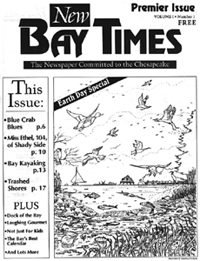
New Bay Times' first exclusive explored the tragic story of kayaker Philipe Voss, who died crossing the Bay. Sandra Martin interviewed the late Miss Ethel, Shady Side's then-103-year-old matriarch. An extensive article investigated the state of the Chesapeake Blue Crab fishery.
All the usual features filled those virgin pages: Dock of the Bay; Not Just for Kids; Real Astrology; News of the Weird; Land, Sea & Sky; editorial, letters - plus both Bay reflection and commentary.
Several features have been replaced. Laughing Gourmet, a food column, has only recently been reintroduced to the mix as Bay Bites. Diversions and Excursions was eventually consumed within the run of our calendar, Good Bay Times. Poli-Talk, which covered the goings-on of politics and legislation relevant to the Bay, is now added to Dock of the Bay's coverage.
"We spent the better part of three months gathering stories for Vol. I No. 1," editor Martin reflected. "Now, we put a new paper out every week."
That first issue was a trial balloon, sent up to determine what reception New Bay Times would receive. We printed 5,000 copies. A week later we reprinted another 5,000. Building our base of readers and advertisers, we published an issue every other week for a year.
By our one-year anniversary, we were printing 13,000 copies every other week. Then, like a player at a blackjack table, we doubled down and began publishing 10,000 copies each week.
Why New Bay Times?
We lobbed around lots of names, from Bay Beacon to Chesapeake Current. Given our focus on Chesapeake Bay, part of its name had to be part of our name.
We were also born of the era when the fragility of this wonderful estuary was on everybody's mind - from the Chesapeake Bay Commission to school kids. "The 'New' and the 'Times' came from our conviction that we'd all have to learn smart, new sustainable life styles to keep the quality in Chesapeake Country," said editor Martin.
"Back in the 1970s," added Lambrecht, "a national magazine called New Times was the most readable thing going. We turned that concept into New Bay Times, and every time I'd see Governor. Glendening, he'd ask: 'Was there ever an Old Bay Times?'"
Of course, New Bay Times is also a formula for keeping a promise. At NBT, we try to provide news and stories that are new and fresh - or refreshing - in these modern times.
The mainstream media do a fine job covering breaking news, but so much of it is negative, focusing on crime and the apparent dissolution of society. It's what I call 'crack, chaos and handcuffs coverage.' Some would say this news only reflects the world in which we live. I believe otherwise. As I wrote in our mission statement:
"New Bay Times' goal is to provide a quality alternative, to focus on the good in society and to explore ways to improve our world."
For six years now, this is what New Bay Times has been doing.
"Build it and they will come," Lambrecht said, and we believed him.
How Do You Make Any Money?
"As a free paper, how do you keep doing it? How do you make any money?" That's the $64 question - one I hear all the time.
NBT has been free from the beginning, thus garnering more readers than a traditional paid subscription paper and - we hoped - drawing a greater paid advertising base.
No one had then tried a free paper in the area, let alone a free paper spanning the better part of two counties and a chunk of a third. (Free weeklies, distributed at shops, businesses, restaurants where readers are out spending money, have since gained a foothold in the publishing business.)
Getting the readers proved easy; the advertising base came more slowly. We had to prove to advertisers that our readers not only read but also bought.
Karl Selinger, owner of the Old Stein Inn, admitted that he was skeptical of advertising with New Bay Times when his son Mike returned from college to help with the family business and began running weekly ads.
The first week the business advertised in NBT, the elder Selinger recalls, a group from a fishing trip came in for dinner. They'd seen The Old Stein's ad in New Bay Times. "That one group paid for our ads for a month and then some," he said. "That paper of yours is a little miracle."
What the Selingers found out, Anna Chaney had already discovered.
"When I first took over Herrington Harbour Restaurant, I tried advertising a lot of places, but I couldn't afford to keep doing that," said owner-manager Chaney. "People tell me all the time that they see my ads everywhere," she added. But aside from New Bay Times, she no longer advertises with other newspapers. "It gets out to so many places so often that it creates the perception that I'm advertising everywhere," Chaney said.
Businesses like these and the partnerships New Bay Times has formed with them have kept the presses rolling these past six years.
It's a synergistic triangle. We provide news, entertainment and advertisements. Readers pick up the paper, read the news and support the advertisers. Over time, more readers bring more advertisers, which allows for more news and more papers for more readers.
In six years, New Bay Times has built up a broad base of advertisers representing a variety of businesses and services. I like to think that I'm the strongest supporter New Bay Times' advertisers could find. I still can't quite do all my business solely with New Bay Times' advertisers, but in our pages I can find a whole lot of goods and services I need, whether it's a good electrician or a good place to eat. I look forward to the day when I can live solely from New Bay Times' advertisers.
Working to make that dream come true is Kathy Flaherty. As our lead ad rep, she begins each cycle checking with her current advertisers, getting their ads ready, making changes. At the same time, she pounds the pavement looking for businesses that will do well in New Bay Times.
Ninety percent of New Bay Times' ads are made in house, and 90 percent
of those are designed by production manager Betsy Kehne. Kehne, Martin's
former student at University of Maryland University College, has been with
us almost from the beginning. Starting as a writer, she juggled her schedule
- she was then a secretary at National Institutes of Health - to begin her
day at 5am to have evening time at the paper. With a degree in art and her
skill as a writer, she evolved into our ad maker and production manager.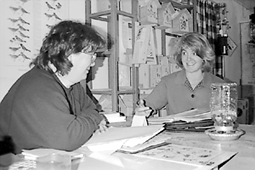
"I loved having the chance to create things that wouldn't just end up in my drawer. Now every week, I feel like I've accomplished something. I try to make you just the ad you want, one that reflects your business and attracts our readers' interest," said Kehne.
Complementing the display ads interspersed throughout the editorial body of the paper are the classified ads at the end of the paper. Classified ads don't stand out the way display ads do. But people read the classifieds and for much the same reason as they window shop: They are looking for something, without, perhaps, knowing what.
photo by Mark Burns Kathy Flaherty, right, sets up a series of ads with Suzie Robertson of Early Birds.
New Bay Times' classifieds are the cheapest around. A one-week, 20-word ad costs only $5. The prices drop from there if you're looking to advertise four, eight or 12 weeks. These ads work well for businesses, products or services needing to get the word out but at a reasonable price.
Adding to the success of the classified section - and the success of those advertising within those pages - are New Bay Times' guaranteed ads. For $25 we will run any item priced below $5,000 until it sells.
That works especially well with boats. As a Chesapeake Bay paper, New Bay Times has a wide range of boats. And when an advertiser complained that all the cheap boats were filling our marine classifieds with junk, we began a "Big Boat" guarantee: Any boat priced over $5,000 we'll run until it sells for $60. That reader's comment has since helped New Bay Times build the best boat listings for a paper our size. If you're looking for your dream boat, you'll find it in New Bay Times.
Ads that work for their buyers because they work for our readers have helped New Bay Times grow to 17,000 papers each week, providing its advertisers an estimated 40,000 weekly readers.
Behind the Scenes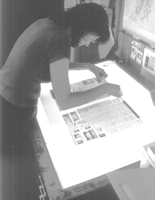
New Bay Times doesn't just happen. What may look like magic is a team effort and lots of hard work.
In addition to a full-time staff of six, regular contributors, freelance writers, artists, interns, volunteers and drivers keep the news coming to you.
Our work week begins - or ends, depending how you look at it - when a new paper hits the streets each Thursday. Within that week, stories are written; pictures are taken; copy is edited; pages are typeset; ads are sold, designed and revised; the paper is printed and the copies delivered.
Computers make possible a lot of what goes on behind the scenes. Fast computers, quality scanners and high-end laser printers significantly cut the labor and production costs of a weekly newspaper from what they were as little as 15 years ago. Photo imaging and art programs like Adobe Photoshop and Illustrator and layout programs like Quark XPress create quality results that once required many skilled workers.
Don't get the wrong idea. New Bay Times is not the result of a bunch of robots.
photo by Mark Burns Betsy Kehne integrates the ads with the pages in preparation for the press.
Beyond the computer-assisted typesetting and design of the near-final product, it takes a regular cycle of good-old-fashioned leg work to come up with the stories and ads that make up each week's paper and then to get it into your hands.
The News You Want to Read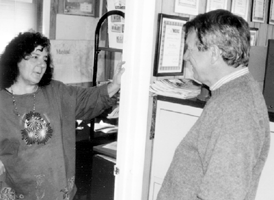
"How do you get your stories?" a young Cub Scout from Pack 853, Den 1, asked on a recent field trip to New Bay Times.
Filling the pages with material that lives up to our own standards and, equally important, to yours, is what keeps you picking up New Bay Times, and it's no easy task. Like any good product, we have a secret recipe aimed to keep you coming back. Choosing the ingredients and preparing each selection is managing editor Sandra Martin.
"You might think you'd run out of ideas, but there's so much interesting in Chesapeake Country, filling a paper each week just takes looking with a fresh eye. We're able to do that because we have so many people - each with a different point of view - eager to prove themselves as writers and make the paper work. Plus, of course, our readers are a never-ending source of good ideas," Martin said.
As editor, Martin is responsible for the editorial content of the newspaper. That demands staying atop current events and local issues. It also helps to have what journalists call a nose for news. Stories are everywhere; the trick is recognizing the people, issues, happenings, history, human interest for the good stories they represent. From there, any good story should answer the Five Ws and the H: Who, what, when, where, why and how.
photo by Mark Burns Many ideas are brought in to editor Sandra Martin by readers like Ron Wolfe.
As a regular New Bay Times reader, you probably know where within its pages to find your favorite features week after week. The general line-up doesn't change; just the news changes.
When I'm out and see someone reading New Bay Times, I look to see - discretely, mind you - what page she's looking at, what page he first turns to. As I see it, you, dear reader, turn first to one of three pages: Real Astrology, News of the Weird or Bill Burton.
Astrology man Rob Brezsny.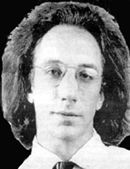
When we talk, one of those readers almost always asks me, "who does those crazy horoscopes?" or "where do you get that weird news?"
Rob Brezsny, a full-fledged astrologer, lives in California and began his column for a small paper in Santa Cruz 20 years ago. Recognizing a good thing, papers from the alternative press - a group of urban, free, weekly papers that provide a different spin than the more conventional dailies and small-town weeklies - sought rights to run Brezsny's column for their readers. Brezsny now provides guiding light for readers of more than 112 papers on five continents.
Chuck Shepherd got a similar start, first writing his News of the Weird for the Washington City Paper in 1988, after a decade of collecting his weirdness for a personal newsletter. With News of the Weird was a national success, Shepherd retired from Washington, moving to Florida where he writes his weekly column, which now runs in over 200 papers.
The popularity of Real Astrology and News of the Weird aside, nobody receives more mail from you than Bill Burton. With 40-plus years in professional journalism, Bill Burton has more than earned his space in our pages, and he does with it as he sees fit. Which is what sparks all those letters we receive, commending or condemning him. And by my take, that means he's doing his job, stirring the pot, and keeping you reading.
After 37 and a half years covering the outdoors for the Evening Sun, Burton brought with him a credibility and celebrity for a small, young paper. "It interested me. It was going to be Bay-oriented," said the veteran.
Writers write for different reasons. Very few do it to get rich - especially at New Bay Times. Bill Burton, who also writes for The Capital twice weekly - as well as for countless magazines and newsletters - writes because, after so many years in the business, he can't stop.
Others write for the fun, to reach a large audience, to improve their craft and to develop their own style.
As intern and former Bill Burton student Darcey Dodd said, "I wanted to write."
Discovering with Dodd that they can write are Kim Cammarata, Christpoher Heagy and Mary Catherine Ball - the latest in a steady stream of aspiring writers who develop their skills at NBT. Like previous interns Stephanie Barrett or Carolyn Martin or Steve Armstrong, many step up to writing careers.
Others, like Carol Glover, at right,
make a writing career at N ew Bay
Times.
ew Bay
Times.
In her four years with New Bay Times, Carol Glover has a niche here. Her local theater reviews span the region, covering plays at Chesapeake Music Hall, Bowie Community Theater, Annapolis Summer Garden Theater and many more.
"I try to convey my love of theater and show how community theater opens up the world to audiences. This job lets me research plays and see how they've been produced by other companies around the country. I get to see and appreciate how actors and companies develop. It's also a very enjoyable way to spend an evening," said Glover.
Many a New Bay Times writer has come to us as a New Bay Times reader. Contributing editor M.L. Faunce began as a letter writer. She has written Bay Reflections and Earth Journal entries. She has written features within New Bay Times' pages and provided stories on her years working within the U.S. Senate and more recently the Maryland General Assembly.
"I like the paper so much that I wanted to write something for it. I liked where I lived so much I wanted to tell all about it. I had to contribute in some way, and I was so pleased to have this outlet for local history, information and nature," said Faunce.
Others, like calendar editor Mark Burns, come to New Bay Times as interns. Small weekly papers like ours give interns a chance to write - not just to open mail and answer phones.
"I was curious about journalism," said Burns. "I thought I could write. I've done a lot of things I never expected, like last week's manure story. Now I know I can write."
Computers and the Internet have created a virtual newsroom. Chris Dollar electronically sends his Chesapeake Outdoors column from home after his day job at Chesapeake Bay Foundation. On the telephone while prompting his computer, Bill Burton sounds like a sailor working his way through a stubborn knot.
Electronic communication makes writing - and for Martin, editing - easier. Writing is no birthright. Like any skill, it's a matter of practice and hard work. The biggest obstacle keeping most would-be writers from writing is re-writing.
Before it reaches our 40,000 readers, editor Martin puts each potential story or column through the ringer to make sure it's sturdy enough to stand up. She tests for correctness, consistency and clarity, making sure that the Five Ws and the H are all answered.
For experienced writers, editing may only entail a little rewording and minor restructuring, perhaps correcting a few grammatical or typographic errors or formatting a story to our style.
For writers newer to the craft, or for larger, more developed stories, Martin spends many an hour working with her writers, helping them to develop their ideas and to communicate them clearly. The corrections and rewrites to bring a potential story to New Bay Times' standards can prove almost unbearable.
"I'm a teaching editor, and we're a teaching paper," said Martin. "We can't make a writer rich, but we can make you a writer. And we can give you 40,000 readers to share your story. But to reach them, you've got to be willing to work with me."
Writers - and editors - tell us how much they've learned with us. "I
want to be an editor," said University of Maryland University College
intern Donna Ayres, who's earned six hours college credit from her work
with the paper this semester. "Because we have weekly columnists, I've
learned to know their voice. After a few weeks, I've learned how to edit
them without muting their voice. I learned from the other side as a writer
from Martin when she edited my feature story on swing dancing. I don't think
I could have learned how to preserve a writer's voice any other way."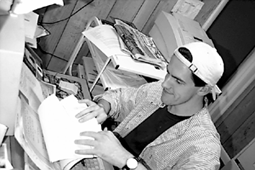
And they tell us it's a thrill and an honor to work for so many readers: "It's a chance to learn about things I wouldn't normally learn about without having to go to school to study them," said Don Kehne, a former University College intern and current editorial assistant. "Plus it's really exciting to see my work in print. I've talked and thought about it a long time, and now it's happened."
But they tell us it can be daunting. "My first piece was 1,000 words, and Martin told me I had to cut it to 500 words. It was the first thing I had published and my first and hardest lesson in journalism. I was thrilled and crushed," reflects Faunce.
Mark Burns sorts through 100s of submissions each week in preparing the Good Bay Times calendar.
Picture Perfect
After each article is written and edited, it is ready for layout and design, where, again with the help of computers, headlines are shaped, text is put into columns and artwork is added to the page. Here the pages take on life, beginning to look like what you hold in your hand.
All this happens in days. Hours really.
Each page begins with a general layout. Will there be any ads on the page and, if so, where? Will artwork be added? Will the story spread to more than one page?
Next, the computer goes to work. We use a layout program called Quark XPress to shape raw text, cast it into type, pour it into columns and wrap it around artwork or ads.
The computer helps us with art work as well as with words. Whether for stories or for ads, art is scanned into the computer on a machine that's a descendant of the photocopier. Ten years ago, this technology was out of the reach of most people and all but the largest businesses. Today, New Bay Times can scan photos, negatives, drawings, small objects and more. What we can't fit onto a scanner, we can capture using a digital camera, which uses no film, instead feeding directly into the computer.
All this technology eliminates darkroom work and most photo processing.
Software programs such as Adobe Photoshop provide all the tools to retouch
and enhance images, often yielding better results than conventional methods.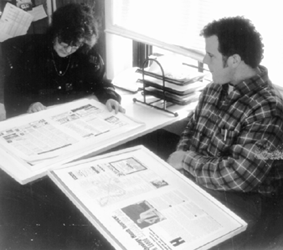
Another reason is cost. In the old days of newspapering, pictures cost time and money. Every picture in every paper was made into a halftone made up of tiny dots of black ink in the surrounding white space. When you look at a newspaper picture, you're seeing only black and white; no gray. Take a magnifying glass to any photographic picture in any publication. Suddenly you'll see the dots. It's this illusion of dots joining together that produces the shades of gray that you see. In color pictures, four basic colors are at work, their dots bleeding together to create the illusion of full color.
Creating these half-tones was an expensive procedure. Now, the scanner, computer and laser printer make it simple and relatively cheap.
When a page comes together and everything fits, it is printed and ready for proofreading. Every story on every page of New Bay Times goes through a rigid check for clarity, typos, misspellings and other mistakes. Each page goes through at least three proofreaders before it returns for corrections and reprinting. Even so, mistakes slip by.
While New Bay Times' pages are being designed, the paper's ads are also being produced through a similar process.
Once pages and ads have been proofread and reprinted, the pages come together in paste-up. Classified manager Nathaniel Knoll prepares the classifieds and begins the paste-up. After finishing the week's Good Bay Times, Mark Burns, helps with the paste-up. Kehne oversees their progress.
Finally, the paper is ready to go to press.
photo by Mark Burns Martin and Knoll check over finished pages a final time.
Hot Off the Presses
By about 5pm each Wednesday, we deliver the pasteboard pages - or flats - of a single copy of New Bay Times to Newsprinters International in Waldorf. In a few hours, the press professionals who work for Orville Davis will return 17,000 copies to our door.
Why not print in-house? It's too big an operation to cram into our Deale
office, for one. It's also quite costly. Besides, where would the paper
be if our multi-tasking writers suffered industrial accidents to their typing
fingers?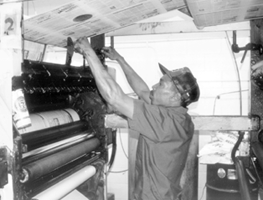
press photos by Mark Burns Pressman Norbert Farme tweaks the presses for quality.
The first stage of printing the paper alone requires five major machines, demonstrated by Tom Crosby - who picked up the printing trade in a government printing shop and has worked here for 12 years. This night, instead of running the presses, he's turning our pages into photo-lithography plates.
Under the red light of the darkroom, our flats are photographed by a six-foot-high, four-foot-wide camera. Developed negatives are spit into a tray hanging outside the darkroom.
Working over a light table, Crosby tapes the negatives together in specially sorted pairs. Those negatives are then burned onto metal sheets coated in green chemicals.
"These are subtractive plates," explains Crosby. "What that means is that it takes the chemicals off in the processor and leaves what was burned on the plate." With the rest of the chemicals gone, a white underside is exposed. The chemicals that remain will hold ink to print with while the slick white surface holds none.
From camera to plate processor takes an hour and a half.
"After the plate crew's done with their job, it comes back to me,"
said Norbert Farme, the press operator. He learned his trade on the job
and has been doing it for 15 years. Under his charge are six vintage press
units and a folding machine, all about 30 years old.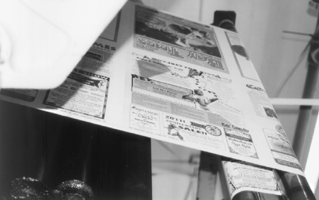
Each plate is loaded onto rollers. The units manage two plates per, with a roller on either side. Warning bells ring as the press starts up slowly with just a tiny bit of ink for the test run to get the timing and alignment just right. Several minutes of Farme's tinkering gets the presses into their groove; when the run is going well they can churn out papers pretty fast. "We can do 14,000 copies per hour, and that's good," said Farme. "But the newer ones out now can do 50 to 60 thousand."
At nearly full speed, the presses raise a deafening din; sections of newspaper fly overhead in an unrecognizable blur. The stream of paper soars toward the folder, which makes quick work of assembling the papers in an intricately orchestrated ballet of mechanics too swift for the eye to see.
Overhead, pipes pump goopy ink from a massive storage tank in the corner to valves at each unit. As the machines run, Farme tends to each, opening valves - one per roller - to let flow the ink that fills the troughs that feed the rollers that ink the plates that print the paper that enlightens the reader.
Havin Baucom, a recent recruit, picks off papers as they roll down the conveyor from the folder and investigates the pages for problems. He's in training to work the press. "I'm not down with the groove on the weeklies yet, said Baucom. "But with the New Bay Times, I'm almost down with that." He helps guide a Darwinian scheme of natural selection, weeding out the batches of misprinted papers and tossing them into the nearby compactor to be recycled.
The good papers rumble down the conveyor and up onto the sorting table where they're stacked by Rick Gray, then passed to Joe Farmer, who bundles them with a string machine and piles them on the pallet. Once done - it takes about two hours from plate to pallet - the papers wait in the warehouse for Jay Manuel, who drops in at six in the morning to pick up his load and deliver it to Deale.
Hitting the Pavement
After Manuel delivers each week's 17,000 papers early Thursday morning, it's time to get the news into our readers' hands. Five route drivers work fast to reach more than 400 drop-off locations - from as far north as Pasadena, west to Crofton and Bowie, from Annapolis south all the way to Prince Frederick in Calvert County - before most people leave work Thursday.
Distribution is key to the success of a paper like New Bay Times. Advertisers are paying for readers, and if those papers aren't on the streets, they're not in readers' hands. And if they're not in readers' hands
Week to week, New Bay Times' drivers record how many papers are dropped at each location as well as the number of any returns. Watching these figures, we can keep our papers flowing where demand warrants.
Into Your Hands
As New Bay Times' general manager, I'm familiar with every aspect of each job. I know each delivery route, and I fill in when the drivers need a week off. For me, delivering a fresh issue of New Bay Times is the most rewarding part of the whole process. Newsprint isn't cheap. This paper in your hands cost a dime. The fact that it is in your hands is priceless.
| Issue 16 |
Volume VII Number 16
April 22-26, 1999
New Bay Times
| Homepage |
| Back to Archives |